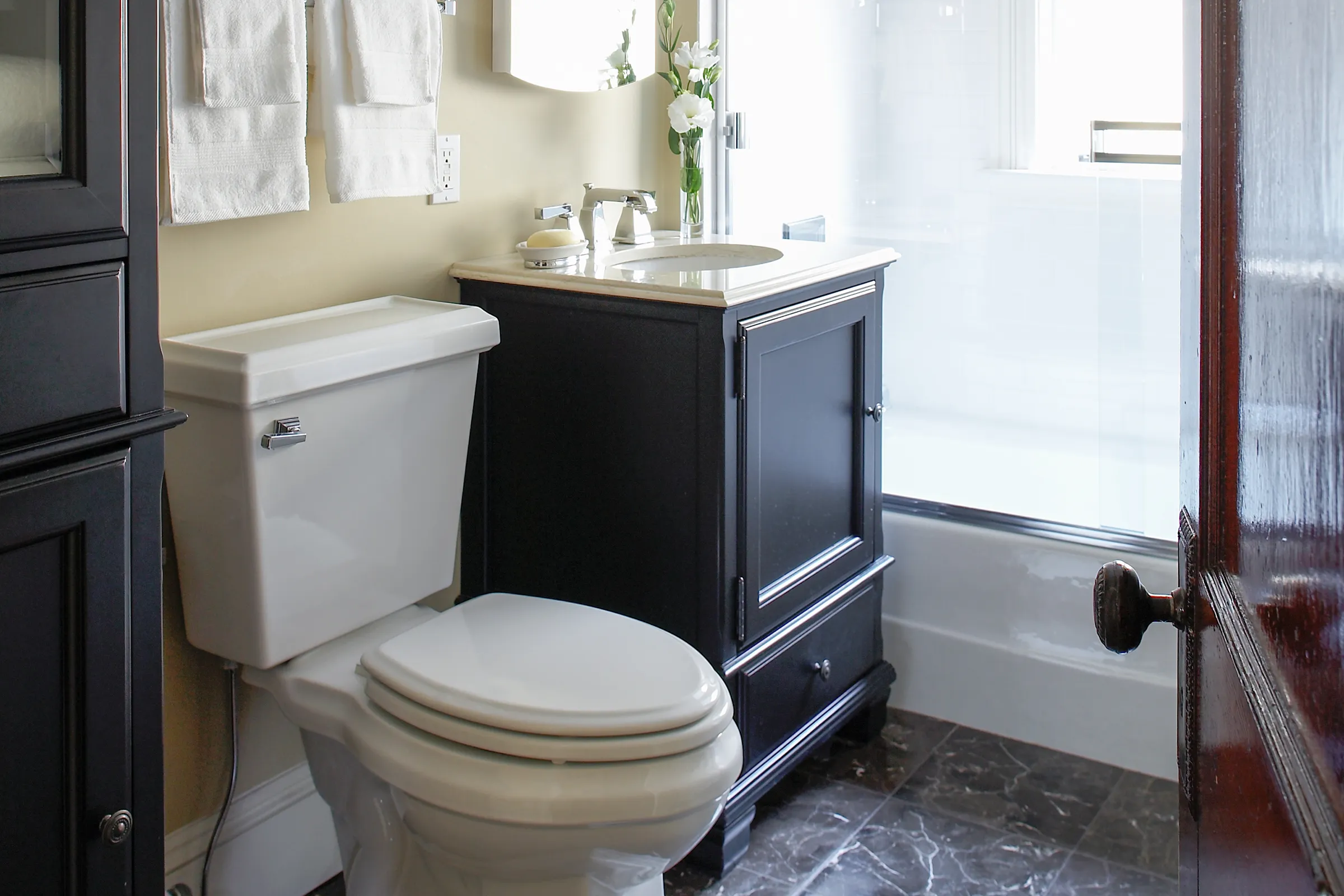Nobody wants to be stuck with a clogged toilet and no plunger. If you find yourself in this precarious situation, there are other methods to get your toilet running properly again. From hot water and dish soap to less conventional methods using a plastic bottle, we’ll walk you through this do-it-yourself (DIY) fix—and tell you when it’s time to call a professional.
Tools and Materials for Unclogging Toilets
Before trying to unclog, make sure you have the following tools and materials on hand:
- Baking soda and vinegar
- Bucket
- Dish soap
- Heat-resistant container (for boiling water)
- Plastic wrap
- Rubber gloves
- Wire hanger
Hot Water and Dish Soap
One of the simplest and most effective methods for unclogging a toilet uses hot water and dish soap.
- Pour dish soap into the toilet: Start by pouring about 1/2 cup of dish soap into the toilet bowl. The soap will help lubricate the pipes and facilitate the passing of the clog.
- Add hot water: Heat a gallon of water to just below boiling and carefully pour it into the toilet bowl. Avoid using boiling water, as it could crack the porcelain.
- Wait and flush: Allow the hot water and soap mixture to work for 15 minutes, then try flushing the toilet. The combination of heat and lubrication often breaks down clogs easily.
Baking Soda and Vinegar Unclogging Technique
This natural method harnesses the chemical reaction between baking soda and vinegar to help clear clogs.
- Add baking soda: Pour 1 cup of baking soda into the toilet bowl.
- Pour vinegar: Slowly pour 2 cups of vinegar into the bowl.
- Wait and add hot water: Allow the mixture to fizz and work for about 30 minutes before adding 1 gallon of hot (not boiling) water.
- Flush: Try flushing the toilet to see if the clog has cleared.
Using Household Items as Makeshift Unclogging Tools
Sometimes, you may need to improvise with household items to tackle the backup. Here are a couple methods to consider:
- Plastic wrap method: Seal the top of the toilet bowl with plastic wrap and press down. The pressure created can help push the clog through the pipes.
- Wire hanger: Straighten a wire hanger and create a small hook at one end. Carefully insert the hanger into the toilet drain to break up the clog. Be mindful not to scratch the porcelain.
Advanced DIY Unclogging Solutions
If the basic methods don’t work, you may need to use tools and specific techniques to get tougher clogs.
Drain Snake
A drain snake, also known as a plumber’s auger, can be a great tool for more stubborn clogs. Here’s how to use it:
- Insert the snake: Feed the snake into the toilet drain until you meet resistance.
- Rotate and push: Rotate the handle clockwise while pushing the snake further into the drain. The rotating motion helps break up the clog.
- Retract and flush: Slowly retract the snake and try flushing the toilet.
Plastic Bottle Method
Although a less conventional approach, you can try using a plastic bottle to create enough pressure to unclog a toilet.
- Prepare the bottle: Find a large plastic bottle and fill it with warm water.
- Position and squeeze: Place your thumb over the top of the bottle, position it at the outlet of the toilet drain, and squeeze the bottle to force water into the drain. The pressure can help dislodge the clog.
Natural and Chemical Unclogging Alternatives
When DIY methods aren’t enough, you can turn to natural or chemical alternatives. These can get the job done, but should be used with caution.
Enzyme-Based Cleaners
Enzyme-based cleaners break down organic waste in the pipes. Pour the recommended amount into the toilet and let it sit overnight before flushing. These cleaners are generally safer for your plumbing and the environment.
Chemical Drain Cleaners
Chemical drain cleaners are stronger, but they should be used sparingly. Follow the manufacturer’s instructions and wear protective gloves. Overuse of chemical cleaners can damage your pipes over time.
When To Call a Professional Plumber
If all else fails and you can’t get the clog to budge, it may be time to call a professional plumber. Hiring a pro guarantees that the issue is handled safely and effectively. A plumber has specialized tools and expertise to handle severe backups safely and efficiently. It’s better to get professional help than risk damaging your plumbing system with repeated DIY attempts.
Plumbing Safety Precautions and Clean-Up Tips
When unclogging a toilet, always follow these safety tips to protect yourself and your bathroom:
- Wear rubber gloves: Protect your hands from germs and chemicals.
- Ventilate the area: Open windows or use a fan to ventilate your bathroom if you’re using strong chemicals.
- Clean up thoroughly: After resolving the clog, clean your toilet and bathroom area with disinfectant to prevent the spread of bacteria.
How To Handle Persistent Clogging
Sometimes, despite your best efforts, clogs might recur more frequently than expected. This could be a sign of a more serious underlying issue that may require upgrading your toilet or an element of your plumbing system.
- Address hard water problems: If you live in an area with hard water, consider installing a water softener. Hard water can cause mineral buildup that narrows pipes and contributes to clogs.
- Get a professional assessment: When clogs become frequent, a plumber can assess your plumbing system for underlying issues. They can use specialized equipment to diagnose problems that aren’t visible to the naked eye.
Our Conclusion
Unclogging a toilet without a plunger is doable if you use the right techniques and tools. From household items to more advanced methods like chemical cleaners or a drain snake, there are many solutions to try. Keep the essential tools on hand and follow preventive measures to minimize future toilet troubles. However, if the clog stays put, don’t hesitate to call a professional plumber for help.

